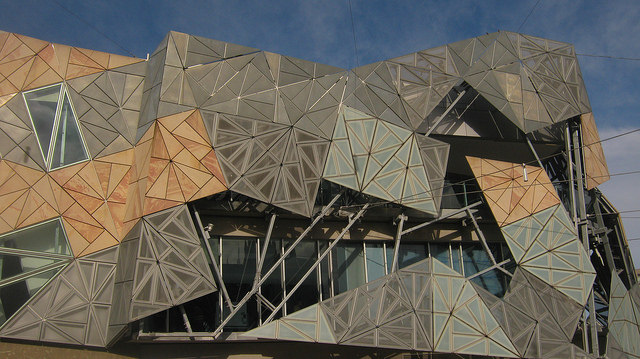On 1 May 2015, tens of thousands of people protested the forcible closure of Aboriginal communities in the mineral-rich state of Western Australia. The support of Aboriginal land rights and political sovereignty inspired solidarity marches across Australia, Aotearoa New Zealand, Turtle Island North America, Europe and Africa. The Narrm Melbourne protest organisers, the Warriors of the Aboriginal Resistance, confronted structurally discriminatory federal politics by proclaiming the Declaration of Aboriginal Nationality.
In March, the Shifting Gear car design exhibition opened on the ground floor of the National Gallery of Victoria’s NGV Australia space in the Ian Potter Centre, Federation Square. Since 2001, the purpose-built ground floor galleries have been home to Aboriginal and Torres Strait Islander art and ceremonial practices. After Shifting Gear opened, the Aboriginal and Torres Strait Islander collection was rehung as Indigenous Art: Moving Backwards into the Future and relocated to the third floor of the building. Logic suggests that the cars are heavy and require the space, but displacing the Aboriginal and Torres Strait Islander presence from prime gallery space, from important cultural ceremonial space, is a genuine cultural blow.
Located at the confluence of Wurundjeri Baluk and Yalukit Wilam territories, the banks of the Birrarung/Yarra River, where NGV Australia is located, are still sacred meeting places. When Aboriginal and Torres Strait Islander art and ceremonial practices were on display in pride of place on the ground floor, visitors could easily encounter the breadth and diversity of the oldest continuing cultural practices in the world. I would imagine the move from the ground floor spaces, to the jam-packed level three gallery is less than ideal for the NGV’s two non-Aboriginal curators of Indigenous art. But it is also unacceptable for the NGV to move the works and gallery spaces without observing cultural protocols and adhering to the wishes of Aboriginal and Torres Strait Islander peoples. Cramming works into a smaller space on the third floor also renders the exhibition tokenistic, especially with much less space afforded the shields and large-scale desert paintings.
There are more changes ahead for Federation Square. Victorian Aboriginal organisation the Koorie Heritage Trust opens its feted new premises there today. The new KHT spaces at Federation Square represent a dream realised, but only if Aboriginal curators and artists come to visibility. Where is the Aboriginal voice in exhibitions at the NGV and KHT when no Aboriginal or Torres Strait Islander curator is in a leadership or supporting curatorial role at either the largest public art museum or the community-run organisation?
Five years have passed since an Aboriginal voice was at the centre of exhibitions of Aboriginal and Torres Strait Islander art and ceremonial practice at the NGV, when Yamatji curator Stephen Gilchrist worked at the gallery (2005-10). He recently wrote about the potential strength of an art institution when Indigenous perspectives inform the way it operates, going beyond ‘us vs them’ scenarios to create ‘culturally resonant’ spaces that can attract and interest multiethnic Australian audiences.
Wardandi curator Clothilde Bullen, until recently curator of Indigenous art at the Art Gallery of Western Australia, further believes Australian art institutions need genuine succession planning before we can see Indigenous agency embedded in their values, structure and programming.
Decolonisation in the Australian context can be defined as the end of intersecting forms of colonial oppression such as patriarchy, heterosexism, capitalism, and race-based hierarchy. Genuine Indigenous presence and agency at the centre of our public institutions will be transformative. Yorta Yorta curator at Bunjilaka Aboriginal Cultural Centre at Melbourne Museum, Kimberley Moulton, is unequivocal:
The problem is that Indigenous people are missing from positions within major institutions and regional galleries. … The number of Indigenous people in leadership roles within the industry is completely inadequate and this contributes to what is often absent – our voice.
Without Indigenous curators who articulate uniquely Indigenous perspectives, both the NGV and KHT are symptomatic of the dispossession of Aboriginal and Torres Strait Islander presence and agency more broadly. The recent protests in support of Aboriginal land rights and political sovereignty are hopeful gestures. When will we move towards decolonising our public institutions? When will diverse Indigenous voices, art and ceremonial practices be embedded into their values and modus operandi?
It would be visionary to catch up with best practice, for the NGV to restore the Indigenous art galleries to their ground floor home at Federation Square overlooking that special, sacred Birrarung/Yarra River. It would be visionary to establish designated Aboriginal, Torres Strait Islander and Pacific curatorial, conservation and collection management positions with decent collecting and programming budgets. An Aboriginal and Torres Strait Islander governing advisory board should be a requirement for all major art institutions, including the NGV. It’s high time our public institutions stepped up to the challenge of a decolonised, shared future.
Further reading
Stephen Gilchrist’s ‘Indigenising Curatorial Practice’, in The World is not a Foreign Land (Ian Potter Museum of Art, 2014)
C Bullen’s ‘A Call to Arms’, in Blak Wave (Next Wave Festival, 2014)
‘Indigenous Curators: Contextualising Culture, Creating Conversations’, in Blak Wave (Next Wave Festival, 2014)
Image: Mario Ray Borg






